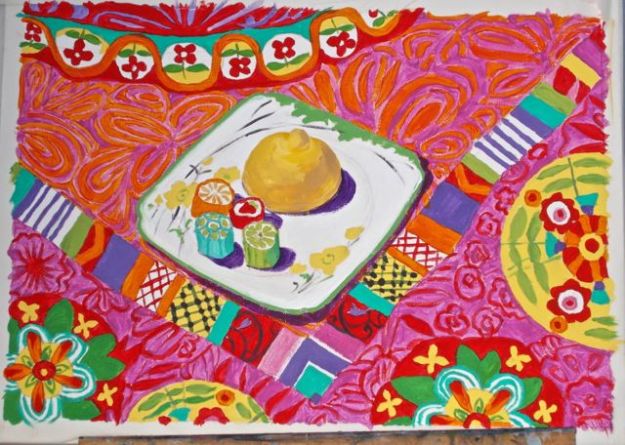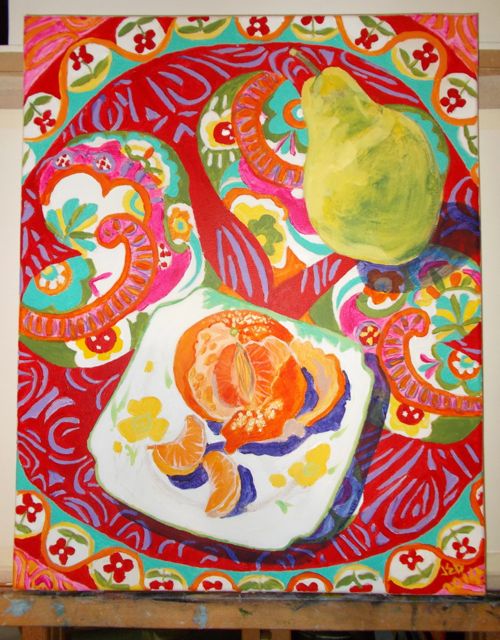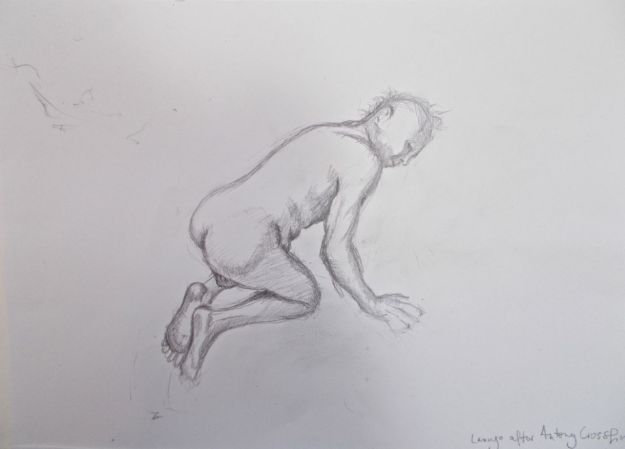
Janet E Davis, Still life with lemon and rock, tinted charcoal, oil pastel and acrylics on primed paper, February 2014. Stage 4.

Janet E Davis, Still life with lemon and rock, tinted charcoal, oil pastel and acrylics on primed paper, February 2014. Stage 3.

Janet E Davis, Still life with lemon and rock, tinted charcoal, oil pastel and acrylics on primed paper, February 2014.
I decided to try sidling up to the process of painting, to lull myself into a false sense of security by starting with drawing. I hadn’t painted since late January or early February 2009. I was very ill at the time. I have been reluctant to go back into my painting space.
It was invaded by a large swarm of wasps in late summer 2009 which had been nesting under the floor. I still find their desiccated corpses in boxes and files, tucked between packets of photographs, or nestling between tubes of paint. Then a year or so later, some furniture and a lot of stuff got dumped in there when two and a half other rooms had to be emptied for building work and I can’t shift the furniture back out again by myself. So my painting space is very cramped these days, which hasn’t encouraged me. The rest of why I haven’t painted since 2009 is in: Artist’s block on one of my other blogs.
So, I started with life drawing when I could afford some sessions. In autumn 2013, I plucked up courage to go to free art classes at the Hatton Art Gallery. I started drawing afterwards at home now and then. I’m still trying to push myself into drawing at least three times a week.
After we did a still life with pastels in the Hatton Gallery, I was determined to try my oil pastels that had been sitting unused in their pristine box for over a year. Eventually, I set up a still life, added some fresh tunes to my iPod Shuffles, put the earphones in and opened the box of colour, aiming to cover a sheet of paper in an evening. The first two are below.

Janet E Davis, Lemon and half a papaya on a silk scarf, oil pastels on paper, 2014.

Janet E Davis, Lemon on vintage teaplate on red and green scarf, oil pastels on paper, 2014.
Then I decided that it was time to open the also pristine box of acrylic paints (trial size) that I had bought at the same time as the pastels. I haven’t painted in acrylics for years, and last time painted pictures with them in my early 20s. I’ve never been an acrylics fan, but they do dry fast. I decided to take photos of it at several stages (at the top of this post). I might wreck it before finishing it, but I don’t think there is a huge amount of work to do on it. I have paused because I have a problem with the pink that I need to complete it. The box of acrylics doesn’t include a pink or a bluish red. I tried initially using white oil pastel layered over a deep pink oil pastel but that isn’t going to work so I will have to commit myself to buying the colour I need in acrylic paint. I still don’t think I like acrylics, but the quick drying time is an advantage.
I’m not sure this is painting. I feel as if I’m still sidling up to painting – but I am thinking about what to put in the next still life now. Any ideas?
Update

Janet E Davis, Still life with lemon and rock, acrylics & oil pastel on sized paper, February 2014.
Final stage of the painting completed Sunday 9th February 2014 and photograph of the almost final version (I tidied up some red areas and the red piece of rock after this).
Postscript
I emailed photos of these pictures to my mother. “I’m worried that the acid from the lemon damaged that lovely scarf,” she said on the phone. I reassured her that no scarves were harmed in the creating of these still life pictures. On the picture with no plate, I’d nestled the fruit carefully on cling film so no juice leaked onto the scarf.





















